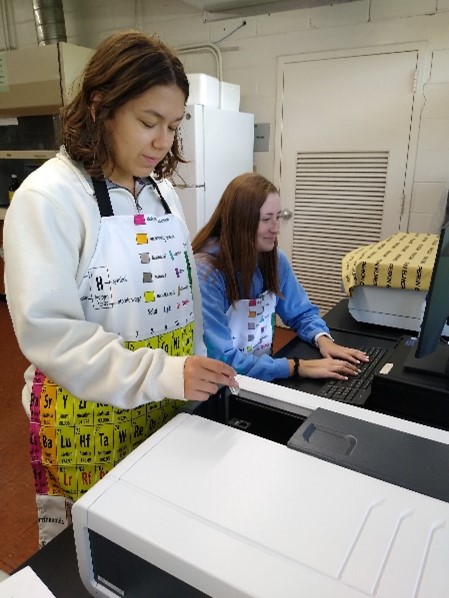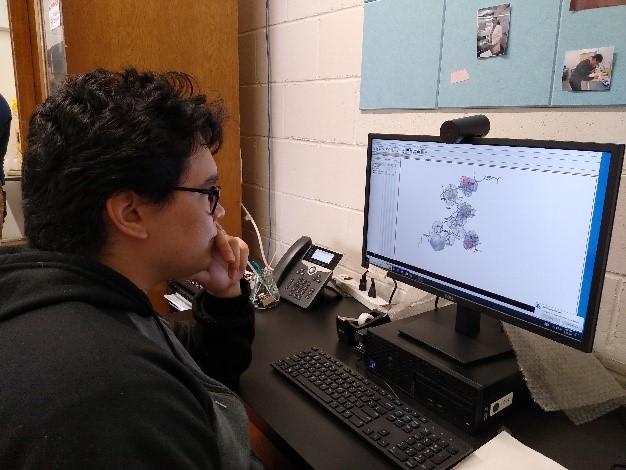
Research
The Department of Chemistry, housed in the Swisher Science and Reid Medical Science Buildings, have fully equipped modern laboratories that are used in student and faculty research as well as lab courses. Instrument capabilities include Nuclear Magnetic Resonance, Nitrogen Plasma Atomic Emission Spectroscopy, Atomic Absorption Spectrometry, Fourier-Transform Infrared Spectrophotometry, Ultraviolet-Visible Spectrophotometry, and Flourometry. Computers and graphing calculators are used in the laboratories, interfacing with the high technology instruments for better data processing.
Close collaborations with the Department of Biology & Marine Science and the Marine Science Research Institute allow Chemistry students and faculty to utilize additional instrumentation and equipment such as plate readers, MALDI-TOF/TOF mass spectrometer, biosafety cabinet, and real-time PCR thermocycler. Intersections between research and policy, advocacy, and communication allow our students to integrate their scientific pursuits with other disciplines. Research opportunities are available in all areas of chemistry: analytical, inorganic, biochemistry, physical, and organic. Students are strongly encouraged to contact individual faculty members and inquire about the possibility of conducting research in the faculty member’s area of specialization. See individual faculty members’ web pages for more information and see just a glimpse of some of these research projects below.
Research Funding Opportunities for Faculty and Students
Assessing Stress Levels and Metal Contaminant Tissue Concentrations in Atlantic Sharpnose Shark Dr. Gretchen Bielmyer-Fraser
In this research, we examined accumulation of heavy metal pollutants and anti-oxidant stress enzymes in muscle tissue of Atlantic sharpnose shark, in collaboration with Dr. Gelsleichter at UNF. The goal of this project was to assess correlations between stress biomarkers and increased metal tissue concentrations across different collection sites, sizes, and gender. These studies will provide new insight into metal accumulation and toxicity in sharks in effort to increase conservation measures.
Assessing Water Chemistry and Metal Pollution in the Lower St. Johns River Dr. Gretchen Bielmyer-Fraser
Anthropogenic impacts on the lower St. Johns River (LSJR) are being investigated and will be publicized by students in the Communications Department. The goals are 1) To describe the presence of metals and characterize various water chemistry parameters in the main stem and select tributaries of the LSJR with different degrees of human impacts; 2) To monitor plankton populations in the main stem and select tributaries of the LSJR and attempt to attribute patterns to natural and anthropogenic influences; and 3) Publicize the resulting data using modern communication tools, such as video segments and social media. This research is in collaboration with Drs. Annmarie Kent-Willette and Melinda Simmons.


Design, Synthesis, and Characterization of Multi-dentate Transition Metal Complexes Dr. Peter Zhao
Transition metal complexes are important for industrial applications and are in numerous enzymes. Structures, properties, and reactivities of transition metal complexes can be varied by changing either the center metal ion or the peripheral ligand substituents, leading to the formation of molecular materials with bulky properties, or bioactive molecules that can help us understand natural bioinorganic mechanisms. We design, synthesize, and characterize multidentate ligands such as polypyrazolylborate, poly(1,2,4-triazolyl)borate, and polythioimidazolylborate due to their versatility and potential binding capability.
Metal Accumulation and Antioxidant Effects in Large Sharks Dr. Gretchen Bielmyer-Fraser
In collaboration with Dr. Bryan Franks and OCEARCH, we are assessing metal accumulation and stress biomarkers in large coastal sharks, such as Great whites. Reference levels of metal contaminants in the tissue samples of sharks, particularly, great whites, is lacking. This study would help to increase knowledge about baseline metal concentrations in the sharks, and metal accumulation and effects in these top level carnivores. The objective of this project is to better understand how humans are affecting great white sharks. We aim to provide new information about the relationship between metal bioaccumulation and chronic stress in large sharks at the top of the food web which may give insight into the impact of metals in coastal ecosystems.
Microcystis Algal Blooms Dr. Anthony Ouellette
Excessive nutrients and warm waters allow Microcystis and other phytoplankton to grow rapidly to high concentrations. In addition to blocking sunlight to submerged plants, the decomposition of blooms can lead to significant declines in oxygen in the water. Both of these situations can wreak havoc on aquatic ecosystems. Furthermore, the production of liver toxins (called microcystins) by Microcystis cause another level of concern. Students use ELISA, MALDI-TOF mass spectrometry, and fluorescence to investigate these blooms and to analyze correlations between chlorophyll levels and microcystin levels as a way to predict toxicity in local waters, as well as identify areas that are particularly prone to toxic events.
Vibrio Bacteria in Sisters Creek Oysters and Water Dr. Anthony Ouellette
Vibrio are bacteria that thrive in warm, estuarine waters. As is common with aquatic bacteria, Vibrio are found attached to particles in the water, and thus can accumulate in filter feeders such as oysters. Students study potentially pathogenic Vibrio vulnificus and Vibrio parahaemolyticus in local waters by analyzing the DNA and proteins of these bacteria that they isolate. The main study site is in Sisters Creek, which is part of the Timucuan Ecological & Historic Preserve and was at one time a shellfish harvesting area.


Elucidating the Structure-Function Relationship in Heme Enzymes Dr. Mary Grace I. Galinato
The structure-function relationship in heme enzymes is critical for understanding how these enzymes catalyze biochemical reactions in organisms. Examples of heme enzymes include hemoglobin and myoglobin (oxygen transport in blood cells and muscle tissue), cytochrome P450s (metabolism of substances like drugs and toxins), and catalases (protection of cells from oxidative damage). Elucidating the structure-function relationship in these enzymes involves examining how their three-dimensional structure such as the heme environment and surrounding protein matrix, influences their catalytic activity.
Previous projects involved studying the reactivity of small molecules (e.g. NOx) on both wild-type and chemically-modified heme systems in order to systematically study the effect of altering an active site component on the redox reaction. In physiology, these molecules have a cascading effect on cellular signaling pathways, inflammatory responses, and blood pressure regulation. More recently, we have been working on utilizing artificial manganese porphyrin protein systems to catalyze the oxidation of sulfur compounds. Results from this fundamental study can be applied, among others, towards more efficient fuel processing, helping to reduce harmful sulfur emissions in a more sustainable and environmentally friendly process. Indeed, heme enzymes and porphyrins are ubiquitous in nature, and studying them for research can provide valuable insights into the role in biological processes, while also contributing to the development of efficient synthetic catalysts inspired by nature.


Synthetic Methodology for Free Radical Addition of the CF3 Group to Various Alkenes Dr. Joseph Cradlebaugh
The synthesis of organic compounds constitutes the back bone of polymer/materials development, pharmaceutical drug development, and bio-materials development. The ability to synthesize compounds which contain carbon-fluorine bonds is particularly useful in the development of psychoactive drugs. From previous work in the area of fluorinated free radical chemistry, it is apparent that following sodium salt of fluoral hydrate forms a carbon centered free radical after initiation. It’s easy to envision that this free radical will add to various different alkenes successfully and give the following trifluoromethyl compound. We are currently exploring the utility of this free radical process, which involves attempted additions to various different alkenes. Additionally, we are attempting these reactions in many different solvent systems.

